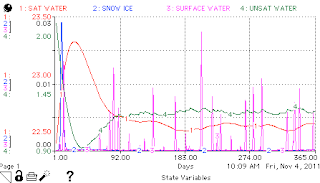How does the model dynamics change if we consider the mortality process
in the last model with the uptake of resource limited by the biomass in
the first trophic level (N = u0T1)? Consider even and odd trophic chains and try to make some generaliztions.
Well, the models' behaviors are interesting and quite divergent. Generalizations are going to be tough. Let's look at the three-trophic-levels model first. With death coefficient (d) = .05, the top predator dies off rapidly and the other two assume a periodicity that is reminiscent of the earlier predator-pray model.
 |
| Three levels, d = 0.05 |
If we decrease the mortality to d = .001, we get very different behavior. The first and third tropic levels decline, while the middle level enters a stable oscillation. I was curious how the system would collapse as levels 1 and 3 became extinct, so I extended the model to run to t = 1000, but the dynamics are unchanged. Levels 1 and 3 continue to decline, but are never eliminated, so level 1 continues to act as a conduit of "N" for level two.
 |
| Three levels, d = 0.001 |
Turning now to the four-level model, with d = .05
, the overall behavior of the system is rather similar to the three-level model with d = .05 (the first set of graphs). There are some quantitative differences, but we see the same oscillations for the two lowest trophic levels (blue and red), and the highest (green) rapidly collapses.
 |
| 4-levels, d = 0.05 |
In contrast, the four-level system with d = 0.001 exhibits very different behavior than the three-level system with d = 0.001. Whereas levels 1 and 3 declined in the three-level system, all four levels are stable in this system. Levels 1 and 3 oscillate roughly in-phase (lower-left scatter plot, note roughly direct proportionality), while levels 2 and 4 oscillate together, out-of-phase relative to levels 1 and 3.
 |
| 4-levels, d = 0.001 |
Generalizations here are tough, but I'll try. One is that alternate trophic levels seem to move together, regardless of other details of the system, and adjacent trophic levels often move opposite each other. These are intuitive when we think in terms of top-down control: If there's a boom in coyotes, the will be a crash in rabbits, which will cause a boom in lettuce. In contrast, if we think in terms of bottom-up control, we wouldn't expect such behavior: a boom in lettuce will yield a boom in rabbits which will yield a boom in coyotes. Perhaps we can conclude that, at least for the system as we've formulated it, predator-based population controls dominate resource-based population controls. I wonder if I can turn down predation and turn up T1's resource use to make it not so... Indeed, just turning up u0, the first trophic level's source breaks the T1-T3 correlation. It also makes the system much flashier. Compare the above lower-left scatter plot, where when T1 is large, T3 is large and vise-versa, with the following lower-left scatter plot, where T1 and T3 appear to be inversely related. The only difference between them is the increased flow to the first trophic level (from 0.1 to 0.5).

And indeed, turning u0 up even further (to 1.0) strengthens the inverse relationship between T1 and T3. So perhaps we can conclude that when reourses at the bottom of the trophic web are abundant, they tend to govern the system, and when they are scarce, predation governs the system. That seems intuitive enough.































